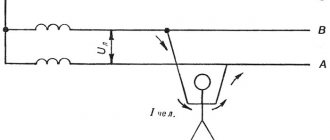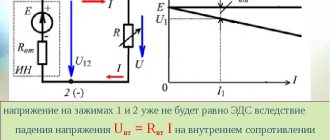Validity of danger
Previously, we briefly touched on why direct and alternating current are dangerous for humans. It's time to look at all the factors in more detail. There are four factors:
- Current and voltage. Current is measured in milliamps (mA). So, for an alternating voltage, a value from 10 to 15 mA is enough under a “standard” voltage of 120 V, and for a constant voltage of about 50-80 with a voltage of U = 42 V to cause harm to a person. However, you should not think that constant therefore becomes safer, because at the same 500 V both become equal in damage caused.
- Duration. It is obvious to everyone that the longer one is under electric shock, the worse it gets. However, not everyone knows why this is so. Being exposed to current for a long time destroys the epidermis and, as a result, reduces the resistance of the body, which automatically “increases” the current strength.
- Frequency. it represents the value of the fluctuations of the poles of the network, which in the CIS countries reaches 50 Hz. However, this unit of measurement has nothing to do with direct current, since in its case the electrons move in one direction. The Skin Effect already discussed is achieved at a frequency above 20 kHz, and this was experimentally proven by Nikola Tesla.
- Resistance. Understanding how it works doesn't require any special knowledge. It is only worth remembering that an increase in resistance is associated with a lower current strength, and vice versa. If there are dry and rough areas of skin on the body, then they can act as a dielectric, which will set the body resistance value from 40,000 to 100,000 Ohms.
- high body temperature;
- damaged epidermis;
- high ambient humidity.
Sweating also reduces the body's resistance because it introduces moisture and increased temperature.
Now we not only know which values are unsafe for humans, but also why this is so.
As a result…
Electric current and its voltage are extremely dangerous for the body. Therefore, it is necessary to follow the simplest safety rules. The current itself can be direct or alternating, with alternating being more dangerous. However, it all depends on the specific situation and a number of factors. One of these factors is humidity, if the humidity of the room is 60%, then a voltage of 65 Volts will be dangerous to health, 75% - 36 Volts, 100% - 12 Volts, with a current of 0.025 Amperes.
Question
Write in the comments what you think is worth saving on safety when working with powerful electrical appliances?
Types of electrical injuries
Electric current passing through the human body can have a number of negative effects that threaten health and life. These include thermal, electrolytic, biological and light.
Just for ethical reasons, we will not post photographs of the consequences of electrical injuries in this publication - this is a terrible sight. Anyone can easily find them on the Internet.
Local electrical injuries are usually caused by thermal effects and most often manifest themselves in the form of burns of varying degrees. In most cases, this does not lead to death, but if the burn is extensive, classified as III or IV degree, then there is a high probability of irreversible consequences.
Exposure to current often leaves electrical marks on the skin - at entry and exit points in the form of spots or dead skin calluses. It happens that such signs are accompanied by metallization of the skin - when it comes into contact with splashes of metal melted by an electric arc.
- The electrolytic effect consists of a sharp disruption of the balanced chemical and biological composition of vital fluids. This primarily affects the blood, but can also affect the lymph and cerebrospinal fluid. The consequences can be very sad, and they can manifest themselves in all their severity even some time after the injury, moving into the chronic stage.
- An electric arc, even if there was no direct electric shock through the skin, can, with its ultraviolet component, cause burns to the cornea of the eye, inflammation of the mucous membranes, damage to the eyelids and lacrimal glands. These are the consequences of electroophthalmia (as such an effect is correctly called), although they are not considered fatal, they can ruin a person’s life for a long time and lead to persistent, long-term or even irreversible deterioration of vision. A typical example is eye burns when performing welding work without protective equipment.
- The most dangerous to human health and life are the biological effects of electric current. Such lesions are more often called electrical shocks. They are accompanied by convulsive uncontrolled contractions of muscle tissue or, conversely, paralysis of individual muscle groups.
Electrical shocks are divided into four groups according to the severity of their consequences:
- The first group - the blow is accompanied by noticeable convulsive muscle contractions, but the person does not lose consciousness.
- The second group - convulsive contractions are accompanied by sharp pain, but without loss of consciousness.
— The third group is loss of consciousness, but without catastrophic dysfunction of the heart and respiratory organs.
— The fourth group is complete loss of consciousness with obvious disturbances of cardiac and (or) respiratory activity.
— The fifth group is electrical shocks that cause clinical death, that is, complete cardiac arrest or complete paralysis of the chest muscles, making breathing impossible.
A particular danger of electrical shocks is the possible induction of cardiac fibrillation. This term refers to the involuntary chaotic contraction of myocardial muscle fibers with high frequency. This sharply disrupts the normal functioning of the heart, leading to the loss of its pumping capabilities, from which it is not far from a complete stop (the heart stops feeding itself with blood) or to profound disruptions in the functioning of the entire organism, including the central nervous system.
Electrical shocks are often accompanied by severe mechanical damage. Convulsive muscle contractions can result in tissue and blood vessel rupture, joint dislocations and even bone fractures. Naturally, all this often leads to painful shocks, further aggravating the condition of the person affected by the current.
Which electric current is more dangerous for humans and why?
Constantly encountering electricity at home and at work, people sometimes forget that failure to comply with basic safety rules can lead to serious consequences, including death. Every person must be aware of the invisible dangers posed by electrical appliances in order to avoid serious electrical injuries.
Which current is more dangerous for human life
Alternating current is used much more often in industry and everyday life. People have long been accustomed to this and few people know that in the 19th century Nikola Tesla and Thomas Edison launched a real “current war”, the results of which determined the further path of industrial development.
One of the arguments given by Edison in defense of direct current was its lower danger to humans compared to alternating current. Under the same conditions (up to 500 V), the force of alternating current on the body is 2-4 times higher.
In the end, the AC concept won. It is much lighter and transmits over long distances with less loss, is easily converted, and is more convenient for the operation of electric motors.
The effects of electric current on the human body:
- Thermal (up to 60%) - heating of the skin and internal tissues up to burns;
- Electrolytic - decomposition and disruption of the physical and chemical composition of organic liquids (blood, lymph);
- Mechanical - stratification and rupture of internal organs under the influence of electrodynamic shock;
- Biological - convulsive contractions of muscle and nervous tissue.
Attention! Loss of consciousness, as well as disruption of the heart and lungs, occurs when the frequency of the electrical flow and heart contractions coincide.
Variable
An electric current that changes in magnitude and direction over time. The flow of electrons constantly oscillates at a certain frequency.
Why is alternating current more dangerous for human life than direct current?
- By its nature, it causes stimulation of the nervous system, contraction and relaxation of muscles, which increases the likelihood of atrial fibrillation, leading to cardiac arrest;
- The frequency of the passing pulse reduces the resistance of the human body;
- An electrical conductor carrying alternating current has a high attractive force.
On a note! The upper limit of alternating current strength that does not lead to damage or serious consequences is 1.2 mA.
Constant
Electric current is the movement of charged particles from minus to plus, the polarity and voltage of which are constant. The flow of electrons goes strictly in a straight line without fluctuations. The severity of the lesion is directly proportional to the amount of voltage applied.
Reasons for the lower danger of direct current compared to alternating current:
- Causes muscle spasm, but does not lead to cardiac dysfunction;
- The resistance of the human body is higher when the electron oscillation frequency is zero;
- A single blow allows you to quickly stop direct contact with an electrical conductor, throws a person back, reducing the duration of exposure to damaging factors on the body.
Attention! The upper limit of safe exposure to direct current is much higher - 7 mA.
Comparison of the effects of alternating and direct electric currents on the body to find out which current is more dangerous.
| Electric current strength (mA) | Alternating current | D.C |
| 0,6–1,5 | Slight tingling | No sensations |
| 2–3 | Mild cramps | -“- |
| 5–7 | Severe cramps | Slight tingling, slight sensation of warmth |
| 8–10 | Severe pain, the upper threshold of the ability to open your hands independently | Symptoms of skin tingling and heating increase |
| 20–25 | Paralysis of limbs, inability to release the current source | Mild cramps, strong heating of the skin |
| 50–80 | Cardiac dysfunction, respiratory center paralysis | Difficulty breathing, severe convulsive spasms |
| 90–100 | Respiratory arrest, possible atrial fibrillation | Paralysis of the respiratory system, the likelihood of the victim being thrown back, causing physical injury |
| 200–300 | When exposed to more than 0.1 s, cardiac arrest, tissue destruction | Thermal destruction of tissues |
Note! It is important to know what current is life-threatening - 50-100 mA, more than 100 mA - fatal.
Why is this or that current dangerous?
The severity of damage to the human body depends on many factors:
- Current and voltage;
- Duration of exposure;
- Type of current and frequency;
- The resistance of the human body is a variable value, depending on many factors.
Various injuries due to electric shock are caused by the nature of the movement of particles: alternating causes chaotic convulsions of internal organs, constant – heating, burns, destruction of body tissues.
Current and voltage
An important parameter that determines the danger of injury is the current strength. An alternating current of 10–15 mA and above is considered dangerous, and a constant current of 50–80 mA.
For humans, alternating current is more dangerous than direct current at the voltages that people most often encounter in everyday life. A direct electric shock occurs at a voltage of 120 V; for alternating current, a similar shock occurs at U = 42 V.
At high voltages (500 V and above), direct current poses the same danger to the body as alternating current. At a higher U, it becomes even more dangerous to humans.
Damage duration
With increasing exposure time, the epidermis is destroyed at the site of contact, the resistance of the human body decreases, and the strength of the flowing electric current increases. Increased sweating at this moment can reduce resistance tenfold. Prolonged contact with electricity causes the accumulation of negative effects on body tissues.
Human body resistance
The law of physics says: the higher the resistance, the lower the current in the circuit. The condition of the epidermis largely determines the amount of general resistance of the human body (up to 90%). Intact, dry, rough skin has dielectric properties. The resistivity of the human body in this case is 40,000–100,000 Ohms.
The value is not constant. Depends on the area of influence and density of contact, the duration of current passage through the body. The thickness of the skin is important - in women and children it is thinner and is more susceptible to damage.
Reasons for decreased resistance:
- High temperature, sweating;
- Damage to the epidermis;
- Increased humidity in the room.
Important! Persons who are intoxicated are at particular risk of electrocution due to a sharp drop in resistance.
Current type and frequency
The number of pole oscillations in a power supply network is called frequency. In Russia and the CIS countries, the standard value is 50 Hz, which means that every second the direction of the alternating current changes 50 times. This unit of measurement has nothing to do with direct electric current; electrons move in one direction.
Reference! The greatest danger is caused by lesions with frequencies in the range from 50 to 500 Hz.
At a frequency above 20 kHz, thanks to the skin effect, alternating current does not cause harm to a person, passing over the surface of the skin and without penetrating into the body. Nikola Tesla proved this experimentally by touching electrodes with his bare hands with a potential of 100 kV with a frequency of 100 kHz.
Under what circumstances can a person be shocked by electric shock?
During operation and repair of electrical equipment, there is a possibility of contact with exposed live wires. You can get an electric shock by touching two wires with different phases. By contacting one phase, a person becomes a conductor, touching grounded metal structures or standing on a wet floor.
In everyday life, the source of damage is often faulty electrical wiring, broken sockets and switches. Electrical injury can result from faulty insulation of electrical appliances connected without grounding.
An electric shock can occur without direct contact with a conductor. In conditions of high humidity and close to a source of electricity, insulation breakdown may occur and an electric arc may occur.
Broken power lines cause wires to come into contact with the ground. They are capable of creating a step voltage within a radius of up to 10 m. A potential difference arises between two points on the surface located at a distance of one human step.
The severity of the injury depends on the path the current travels through the human body. Electric current always travels the shortest distance towards the ground.
Difference between the two options being compared
So, first of all, we will briefly explain to you what is the difference between alternating current and direct current. The main difference is that in the first case, the directed movement of charged particles will proceed straight, and in the second case, in a chaotic direction. The graph below clearly shows the difference between the two options being compared and at the same time provides a brief description of how AC and DC current flows in the circuit.
In addition, it should be added that direct current at home most often flows in lamps - for example, if the room has hidden lighting with LED strip. At the same time, alternating current flows in all sockets, distribution boxes and panels, so its danger to human life is more urgent.
Safe voltage for humans according to PUE - Safety Portal
Walking through a vacant lot or in a forest, in a field, near power lines, and even in a city near your house, when you see a cable lying on the ground, do not rush to rejoice at your find and the possible benefit because it can be dangerous. Like a stone thrown into water, the current spreads in all directions, weakening with every centimeter. Electricity is colorless and odorless, and does not manifest itself in any way if there is no contact. It is impossible to determine by eye whether there is voltage in the wire or not.
Safe exit from the affected area
A distance of more than 20 meters from a high potential source is considered safe. Despite this, it is considered that the maximum radius of damage from step voltage is 8 meters if the dangerous voltage at the break point is above 1000 volts and 5 meters if the value does not exceed 1000 volts.
At the same time, starting from 380 V and above, voltage is considered dangerous, because capable of causing such a stepping potential. To leave the danger zone and exit safely, you do not need to run quickly, taking long steps. Step voltage increases as step length increases, and vice versa. As long as your feet are nearby, there is no threat to life.
You need to leave the zone of high electrical potential by stepping from foot to foot, taking a small step within the size of your foot (this movement is also called a goose step). Under no circumstances try to jump out of the affected area on one leg.
This method of exit is certainly effective, but if you fall on your hands or elbows, a step voltage of a higher magnitude will arise, which can immediately lead to death.
You can also familiarize yourself with the conditions for safe exit from the area of spreading electric current by watching video tutorials:
How to move near a power line break and in what cases the danger is reduced
How to free a person?
If you were not alone and your companion in front suddenly fell, falling into the zone of spreading step voltage, because the electric current caused an involuntary contraction of the leg muscles, you should not rush towards him. You need to assess the situation and approach him in small steps, wrapping your hands in dry clothes, pulling the victim away from the affected area.
You can also come under step voltage at home by touching a faulty electrical appliance plugged into the network, thus forming an electrical circuit. To avoid such accidents, it is necessary to install an RCD in the apartment panel or organize a grounding system together with a potential equalization system.
What to do if you see a person exposed to electric current in a room? Don’t panic, the first thing you need to do is break the circuit by turning off the switch or circuit breaker. If this is not possible, use a dry wooden object, wrapping your hands in dry clothing, remembering your safety, and try to free the victim with this object by throwing it away or placing it between the person and the source to break the chain. The pictures below show the measures that need to be taken to free the victim, including after a step voltage injury:
After freeing the person, pull him to a safe place, feel the pulse and look at the reaction of the pupils to light. Call an ambulance and begin emergency cardiopulmonary resuscitation, artificial respiration and cardiac massage until the ambulance arrives.
If the victim regains consciousness, place him on his side so that a sudden gag reflex does not enter the respiratory tract. You can find out more clear step-by-step actions in our article - how to provide assistance in case of electric shock. Remember that each point in the rules is the life or bitter experience of the victim.
That's all I wanted to tell you about what step voltage is, what is the reason for its occurrence and, most importantly, how to identify the danger and leave this area. Take care of yourself and we remind you once again - avoid broken wires, at least 8 meters away, because at such a distance the dangerous potential is reduced to zero.
What voltage is considered acceptable?
Statistics indicate that most electrical injuries occur from touching exposed wires. There are three safe voltages:
- In rooms where there is no increased danger, 65 volts are allowed.
- In a room where there is danger - 36 volts.
- In high-risk areas - 12 volts.
In premises of the second and third types there must be a “high voltage” sign, which will warn of danger. Often, injuries occur to employees who, by the nature of their employment, are required to work with voltages up to 1000 V, but neglect safety precautions and do not use protective equipment.
The answer to the question of what voltage is considered dangerous can be quite simple: any electric shock can cause damage, but the most dangerous is considered to be voltage from 60 V, when respiratory paralysis and cardiac arrest can occur. But this may not happen if you pay close attention to everything that surrounds a person and in some way relates to electricity. Personnel who work with high voltage and electric current must always remember safety rules and be on high alert.
So, from this article you learned what voltage is life-threatening. We hope you find this information useful.
Safe current for humans according to PUE - Fire safety
Installations and equipment that are associated with the production, transformation, transmission, distribution, conversion of electricity pose a serious risk in terms of harm to human health and fire hazard. Therefore, the presence of electrical installations in production obliges management to equip premises with such equipment according to special rules stipulated in the PUE - rules for the installation of electrical installations.
Classification of electrical installations
The classification of the equipment itself helps to properly secure the premises in which electrical installations (EI) are located, according to the rules. So, electrical installations differ:
- According to operating voltage:
- By purpose and location:
- external – for installation outdoors, protected by nets and canopies from exposure to precipitation;
- internal ones are closed.
Safe fire extinguishing of electrical installations
The danger facing electrical installations is electric shock to a person.
Moreover, this is possible both in direct contact of a person with live parts, and in the process of extinguishing electrical equipment, when the fire extinguishing agent serves as a conductor of electric current.
Safe power supply of electrical installations can be ensured if the following rules are followed:
- do not start extinguishing a fire without the appropriate permission of the person in charge of the shift;
- at least two employees must extinguish the fire;
- comply with the requirements for ensuring the safety of production work before starting to extinguish the fire.
Fire extinguishing in rooms with electrical installations is carried out with a sprayed stream of water, which is supplied from a distance of at least 5 m, or with air-mechanical foam. Fire extinguishers may also be used:
- freon - at EC voltage up to 0.4 kV, from a distance of more than 1 m;
- powder – up to 1 kV, more than 1 m;
- carbon dioxide - up to 10 kV, more than 1 m.
In addition, fire extinguishing conditions differ in rooms with different fire hazard classes.
Industrial premises containing electrical installations, according to the PUE, differ in the degree of danger of electric shock to humans. Based on this criterion, premises are distinguished:
- Increased danger. Options:
- increased dampness (air humidity more than 75% for a long time);
- the presence of conductive dust settling on wires and getting inside the installations;
- the presence of conductive floors - earthen, brick, metal;
- high temperature (more than 35 degrees constantly);
- metal building structures connected to the ground, technological mechanisms, metal casings of installations located within human reach.
- Special danger. Options:
- a large amount of moisture in the air (about 100%), on the ceiling, walls, floor;
- the presence of a chemically aggressive environment - vapors, gases, liquids that can destroy the insulation and conductive elements of installations.
- No increased danger.
Particularly dangerous areas include areas where outdoor electrical installations are located.
Requirements for rooms with electrical installations
To ensure the safety of personnel servicing electrical installations, the requirements for the premises where this equipment is located are strictly regulated.
There are sites where repairs and installation of installations are carried out. If necessary, organize lifting mechanisms.
Noise and vibration vibrations during installation and repair work should not exceed permissible limits.
In addition, the distances between the building and electrical installations moved to the installation site are standardized:
- vertically - not less than 30 cm;
- horizontally - not less than 50 cm;
- The width of the passages is not less than 100 cm.
In high-risk and special-hazard areas, including outdoor installations, protection from direct contact is provided if the voltage in the power supply is 25 V AC and 60 V DC. If the operating voltage is not more than these values, and the equipment is located in the potential equalization zone, protection is not required.
Relief from electric current
In case of electric shock, it is necessary to free the victim from the effects of shock as soon as possible, because The severity of the electrical injury depends on the duration of this action.
Touching live parts that are energized in most cases causes involuntary convulsive muscle contractions and general agitation, which can lead to disruption, even complete cessation of the respiratory and circulatory system.
If the victim holds the wire with his hands, his fingers become so tight that it becomes impossible to free the wire from his hands.
Therefore, the first action of assistance should be to immediately turn off that part of the electrical installation that the victim touches.
Disconnection is carried out using a switch, switch, and also by removing or unscrewing fuses.
If it is impossible to turn off the installation quickly enough, it is necessary to take other measures to free the victim from the action of the current.
In all cases, the person providing assistance should not touch the victim without proper precautions, because it's life threatening
He must also ensure that he himself does not come into contact with the live part and under step voltage.
Voltage up to 1000V
To separate the victim from live parts or wires with voltage up to 1000V, you should use a rope, stick, board or dry object that does not conduct electric current.
You can also pull him by the clothing (if it is dry and lags behind the body), for example, by the hem of a jacket or coat, by the collar, while avoiding touching surrounding metal objects and parts of the victim’s body that are not covered by clothing. When pulling the victim by the legs, the person providing assistance should not touch his shoes or clothes, because shoes and clothing may be damp and conduct electrical current.
To isolate the hands, the person providing assistance must wear dielectric gloves or wrap a scarf around the hand, put a cloth cap on it, throw a rubber mat or just dry cloth over the victim. You can also insulate yourself by standing on a rubber mat, dry board, or non-conductive sole. When separating a victim from live parts, it is recommended to act with one hand, holding the other in your pocket or behind your back.
If an electric current passes into the ground through the victim and he convulsively squeezes one current-carrying element in his hand (for example, a wire, it is easier to interrupt the current by separating the victim from the ground), slip a dry board under him, or pull him by his clothes. You can also cut the wires with an ax with a dry wooden handle or cut them with a tool with insulated handles (nippers, pliers). It is necessary to cut the wires in phases, i.e. each wire separately, and it is necessary to stand on dry boards or a wooden ladder.
Voltage over 1000V
To separate the victim from live parts energized above 1000V, you should wear dielectric gloves and boots, use a rod or insulating ends designed for the appropriate voltage. In this case, one must remember about the danger of step voltage if the live part lies on the ground and after freeing the victim from the action of the current, it is necessary to remove him from the dangerous zone.
On power lines, to free the victim if he touches the wires, short-circuit the wires by throwing a flexible, uninsulated wire over them.
The wire must have a sufficient cross-section so that it does not burn out when a short circuit current passes through it. Before making a surge, one end of the wire must be grounded (connect it to the body of a metal support, grounding descent, etc.). The conductor must be thrown so that it does not touch people, including the person providing assistance and the victim. If the victim touches one wire, it is often sufficient to ground only that wire.
Types of effects of electric current on the human body
Based on the type of electricity that affects the human body, the following types are distinguished:
- Biological – manifested by irritation and excitation of body tissues, disruption of biological processes, which may result in cardiac and respiratory arrest. Also, current can suppress very biocurrents flowing in the human body, and thereby cause serious disorders in the body, including its death.
- Thermal - burns of certain areas of the body: the skin at the point of contact with the electrodes and internal organs and blood vessels along the path of electric current, as well as from the effects of an electric arc or spark formed when a short circuit occurs or a person approaches close to places under high voltage.
- Electrolytic - decomposition of biological fluids, including blood, as a result of which their physicochemical composition is disrupted.
- Mechanical – leads to delamination, rupture of body tissues as a result of the electrodynamic effect, as well as the explosive formation of steam formed when biological fluids boil under the influence of current. Severe cramps can cause dislocations, ruptures of muscles, tendons, and even fractures.
Return to content
Factors influencing the extent of damage
DC shock is dangerous. But you can get rid of its influence without the help of outsiders at values from 20 to 25 mA.
The effect on the body of alternating current with a frequency of 50 – 500 Hz is more dangerous. A person can independently free himself from its influence only at very low values, ranging from 9 to 10 mA.
What current strength in a circuit depends on the voltage in this circuit and the resistance of all its elements, including the resistance of the human body. Dry skin has a higher resistance, approximately 100,000 ohms. Wet - only about 1000 Ohms. The resistance of internal organs is in the range of 500-1000 Ohms.
If the voltage applied to the body increases, the body's resistance decreases disproportionately. The same thing happens with increasing duration of exposure to electricity, as well as with poor physical and mental condition of a person.
The graph shows that if the voltage increases from 0 to 140 Volts, the body resistance drops from 10,000 to 800 Ohms. This nonlinear relationship is reflected by the first curve. The second curve shows that the current passing through the human body increases with increasing voltage.
How severe the electric shock will be depends on the time of its exposure to the body. If the influence continues for several seconds, the body's resistance decreases, and accordingly the current increases, which leads to serious consequences. If the exposure time is less than a tenth of a second, then the likelihood of cardiac fibrillation is reduced, and the likelihood of saving life increases.
It follows from the table that, for a favorable outcome, the duration of exposure to 65 mA at a calculated 65 V should not exceed 1 second.
I repeat that in the table of calculated currents at different voltages the resistance of the body is assumed to be 1000 Ohms; in reality, it is impossible to predict the value of the effective current, since the resistance of the body depends on a number of factors.
The mechanism by which electricity affects the human body is complex. It happened when in high-voltage installations a short-term shock of a few amperes did not lead to death. Whereas a voltage of 12-36 V and a current of several milliamps were fatal to humans. The cause is a lesion caused by touching the conductors of the most vulnerable part of the body: neck, cheek, shoulder, back of the hand.
How can current affect the human body?
Electric current can instantly spread upon contact throughout the body. In order for it to pass through the body, it needs an “entry” place, and then the current, passing through the entire body, has an irritating effect on it. For example, the effect of current on the human body is divided into several types:
- Thermal, when you get a burn.
- Mechanical, when soft tissue ruptures.
- Chemical is directly electrolysis itself.
As a result of an electric shock, a person’s muscles may involuntarily contract, breathing may be paralyzed, and the heart may stop.
What determines the degree of damage?
Electric shock from the same source can affect different people with different degrees of severity, since it depends not only on the power and voltage, but also on the individual characteristics of a particular person.
Type, strength and voltage of electric current
The voltage of the electric current directly affects the result of the electric shock and its consequences. The higher the voltage, the more serious the consequences.
There are:
- low voltage (up to 1000 V);
- high voltage (over 1000 V).
To cause an electric shock, a voltage of only 100–200 V is sufficient, and a person may experience muscle spasms and loss of consciousness. Higher voltage currents cause serious organ injuries and burns, and sometimes death.
High-voltage shock can occur without contact (electric arc through conductive surfaces at step voltage).
Current strength characterizes the charge passing through a conductive surface over a certain period of time. The human body is capable of sensing currents of 1 mA and higher. Moreover, the higher the current strength, the more difficult it is to break physical contact with the current source.
There are 2 main types of electric current: alternating and direct. The most dangerous is considered to be alternating current. It is characterized by frequency (oscillation period), and with a low-frequency impact (up to 60 Hz, used in everyday life) it is much more noticeably perceived by a person.
Therefore, the maximum permissible safe threshold for the impact of current on the body in a constant state ranges from 10 to 50 mA, and in an alternating state - only up to 10 mA. Exceeding these indicators is accompanied by severe convulsions, disturbance or cessation of breathing and cardiac activity.
Duration of contact with a source of electricity
The length of time the body is exposed to electric current directly affects the severity of the electrical injury.
The longer contact with an energized source occurs, the more likely it is that damage will occur during the T phase of the cardiac cycle (when muscles change from a tense state to a relaxed state). In this case, cardiac fibrillation and death are possible.
Exceeding the permissible safe indicators of exposure to alternating and direct current or reaching their critical values (10 mA and 50 mA, respectively) during direct contact leads to the impossibility of unclenching the hands and releasing them from the source of electric current.
Prolonged contact can occur not only as a result of contact with a source of damage, but also without contact (for example, when current spreads across the floor as a result of a break in high-voltage wires).
Current path through the body
Electrical current can travel through the body in different ways, called flow loops.
Its movement from the entry point to the exit points depends on the voltage:
- when high, the current travels the shortest path through the body;
- at low – movement occurs along the path of least tissue resistance (through blood, muscles, mucous membranes and nerve endings).
The loop can go through one of the following options:
- hand - hand (upper);
- hand leg;
- hand - both legs;
- head - hand;
- leg – leg (lower);
- head - leg;
- head – both legs;
- arm + leg – arm + leg (full loop).
The first and last options are considered the most dangerous, since the electric current passes through the heart. A particular threat is posed by a loop passing through the head and affecting the brain.
Physiological state of a person
The degree of electric shock is influenced by general indicators of human health.
People who are most sensitive to electrical injuries are:
- having diseases of the cardiovascular and nervous system;
- with severe symptoms of fatigue;
- suffering from chronic diseases of the respiratory system, endocrine and nervous systems, skin, heart;
- suffered heatstroke;
- showing signs of exhaustion.
Environmental factors
The strength of the effect of electric current on the body can be influenced by external factors:
- high air temperature (over + 25 C);
- low atmospheric pressure (less than 740 mm);
- air humidity more than 75%;
- the presence of an electric or magnetic field;
- proximity of current-carrying conductors;
- the presence of chemicals and caustic gases that violate the integrity of the insulating shells of power sources.
Dangerous current values
Electrical injury is affected by the following three factors, which determine the result:
- Current strength.
- The direction in which current flows through the body.
- Frequency (variable or constant).
Electric current is also classified according to its strength depending on how it affects human health:
- Noticeable (nothing serious, irritates the skin, up to 0.6 milliamps).
- Non-releasing (periodic alternating current pulses, the person seems to be stuck to the source, current strength is more than 0.025 Amperes).
- Fibrillation (the most dangerous, causes fibrillation of internal organs, including the heart; if the current is more than 0.1 Ampere, then death is possible).
Additionally, a lot depends on the individual resistance of the human body, which is not only different for everyone, but also varies depending on various factors. Therefore, the force of the blow may also depend on the psychological state (mood) and general health, not to mention properly selected shoes and clothing.
Based on safety regulations, the following voltage indicators are dangerous for the body:
- 65 Volts - for ordinary residential and public premises that are heated, and their humidity reaches 60%.
- 36 Volts – for rooms with high humidity levels (75%), these are kitchens, basements, etc.
- 12 Volts - for extremely wet rooms (100%), these are boiler rooms, bathhouses, laundries, swimming pools, etc.
Be aware that the frequency of electricity can also be dangerous. The current in household sockets (50-60 Hz) and in devices where it is higher (up to 500) is approximately the same in impact. When the frequency is 500-1000 Hz, the current is more dangerous, but above 1000 Hz, on the contrary, the chances of injury are less.
Source yandex.net











